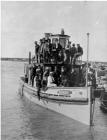15
Captain Horatio Ross on the Nipawin looking down on an ore barge.1920
En route Sturgeon Landing, Saskatchewan to The Pas, Manitoba, Canada

18
Steamboats were also utilized in the transport of raw natural resources in the lumber and mining industries. From 1912 until 1953, The Finger Lumber Company and then its' successor, The Pas Lumber Company, used river steamers and tugs to guide and maneuver log rafts during the annual log drives on the Saskatchewan River.The river drive was much less labour-intensive and more economical than hauling logs overland. Throughout the winter, logs were pulled from the bush landings by horse and sleigh and stockpiled on the ice of the Carrot River and other Saskatchewan River tributaries. At breakup when the rivers opened and swelled with meltwater, the logs were floated downstream to the lumber mill at The Pas.
The largest of The Pas Lumber Company's steamboats was the David N. Winton, a 120-foot boat that was used during 30 years of log driving.
20
Riverboat transport was used for a short time by the mining industry in the area. Transporting raw materials from remote locations over tracts of rocky forest, swamps and lakes in Manitoba's north has long been a challenge. The Mandy Mine operated on Schist Lake near present day Flin Flon, and in the beginning was not serviced by road or rail.For eight seasons starting in 1917, more than 25,000 tons of copper ore were shipped over 200 kilometres by barge from Sturgeon Landing, across Cumberland Lake, out the Bigstone River, and down the Saskatchewan River to the railhead at The Pas. The ore was then shipped by rail to a smelter at Trail, B.C. This ore was barged by the Nipawin, a Ross Navigation Company sternwheeler some 86.8 feet in length. Her career as an ore vessel ended in 1925 when the railway was extended from The Pas to Flin Flon.
21
Ross Navigation Company's Nipawin1920
En route Sturgeon Landing, Saskatchewan to The Pas, Manitoba, Canada

22
David N. Winton passing through the railway bridge on the Saskatchewan River.1940
The Pas, Manitoba, Canada

24
Steamboats were used to transport passengers as well as payloads of freight. On the larger steamboats, passengers had a choice of seating, either in cabin or on deck. The cabin was only affordable to the more affluent passengers - a more upscale mode of passage that was priced out of the reach for the average passenger.Meals were charged in addition to passage, and passengers on deck had to provide their own bedding. Each passenger was given a 100-pound allowance for baggage. In the event of a boat accident or serious grounding, passengers were required to make the remainder of the voyage at their own expense.
25
S.S. King George V moored for the winter below the railway bridge at The Pas.1917
The Pas, Manitoba, Canada






